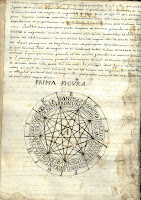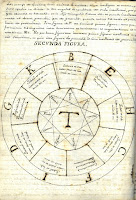 This poor guy has had half of his head sliced off. It looks like an executioner swung about eight inches wide and missed the neck, but still did the crucial job. But, that is not what is going on here. This is an image from Charles Estienne's De dissectione partium corporis, an anatomy text from 1545 that was meant to rival Andreas Vesalius's famed De humani corporis fabrica of 1543. The image here shows the structure of the brain in rather dramatic fashion.
This poor guy has had half of his head sliced off. It looks like an executioner swung about eight inches wide and missed the neck, but still did the crucial job. But, that is not what is going on here. This is an image from Charles Estienne's De dissectione partium corporis, an anatomy text from 1545 that was meant to rival Andreas Vesalius's famed De humani corporis fabrica of 1543. The image here shows the structure of the brain in rather dramatic fashion.If you look a little closer, you'll notice an odd square around the top of the head. The effect is more pronounced in other illustrations in the book. You can really see it here:
It turns out that Estienne was dissatisfied with the woodblocks for the book, and had portions of them recut to emphasize crucial anatomical detail. The result is a woodcut inside of a woodcut. He clearly saw the original as a failure of execution--on the part of the woodcut artist.
We are lucky enough to have first editions of both of Estienne and Vesalius. To see them ask for Rare QM21.E82 and Rare QM25.V4.


